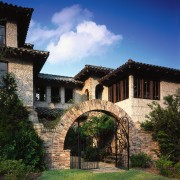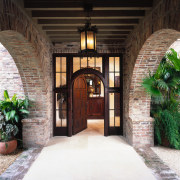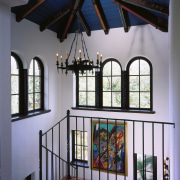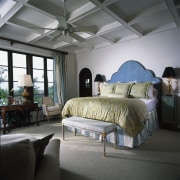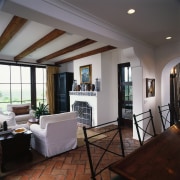Casa grande
Spanish and Moorish accents give this home a sense of history and permanence – a marked contrast to the ever-changing marshland it overlooks

Architecture is often a direct response to its surroundings – and this is particularly true when it sits on an expansive, rural estate. When architect Keith Summerour created this home on a 20-acre estate, its scenic environment impacted on the design in several ways. “The home’s surrounding marshland changes every day – with reeds appearing black one day, emerald the next and red the day after,” he says. “In contrast to this, the home‘s fusion of classic Spanish and Moorish architecture is designed to exude permanence.” An entry court, wrought iron gates, fountains, terra cotta roof tiles, tabby mortar and brick sidings and mahogany window frames all contribute to a sense of classic longevity. The sense of architectural history is extended by the use of non-supporting arches and even unusual window positionings – both giving the impression that they are hangovers from an earlier structure, that has since been built over. In contrast, the ever-changing natural world reaches almost literally to the front gate. A wrought iron entry gate, designed by Summerour, depicts an oak tree with stylized waving marsh grasses at its base. While the plants and tree depicted are local, the idea of infusing architecture with graphic elements has precedents in Moorish architecture. “Building in such dramatic surroundings means there can be no designated rear to the home,” he says. “There is a main entrance on one side, but the other side is equally important, due to the scenery.” To this end, the Spanish style architecture, with entry courtyards and open terraces, provided gracious facades on all sides. The terraces and arches also maximize occupants’ views of the scenery. “The wetlands affected the design in other ways, too,” says Summerour. “To further extend the view, the home has a high elevation, and there is another reason. Built over three levels, the basement has been left relatively unadorned, in case frequent hurricanes in the area bring swamp waters right up through the home.” Instead of formal living spaces, the lower level offers terracing out to the pool as well as a rumpus area for the home. The second level includes a formal salon, informal living areas, the kitchen and master bedroom. Children’s bedrooms are found at the top of the home, via a feature staircase. “The Moorish accents are carried through on the interior as well,” says Summerour. This is evident from inside the solid mahogany front door. Wood window frames, wrought ironwork, white plaster walls and limestone floors all suggest southern Spanish influences. Situated a few steps up from the entrance, the formal salon has arched windows which echo the exterior terrace arches beyond. Overhead in the salon, a rustic pecky cypress ceiling has a blue-green wash, with rafters stained in a walnut hue. A similar ceiling over the staircase, here washed cobalt blue, features decorative stencilling, adding to the Spanish feel. Lisa Torbett was the interior designer on the project and explains the look required. “A central consideration was to not detract from the ever-changing panorama outside. To this end we created Spanish off-white interiors, at the same time incorporating the many objects collected by the owners on their travels.” Again not to detract from the view, colors are restricted to highlights such as Arabic antique lamps, artworks and jewel-toned cushions. “In place of overwhelming colors, textures are featured – with soft silks and chenilles in the formal areas and earthy textures, such as sisal, in the family rooms off the kitchen,” Torbett says. Summerour says the home’s raw Spanish exterior belies the comfortable interior from which occupants look out on the ever-changing marshlands.
Credit list
Interior designer
Sidings
Kitchen designer
Countertops
Master bathtub, basin
Builder
Roof
Interior doors
Kitchen manufacturer
Oven, range
Ventilation
Cabinetry
Story by: Trendsideas
Home kitchen bathroom commercial design
Classic looks, contemporary efficiency
Diving into nature
Personality plus




